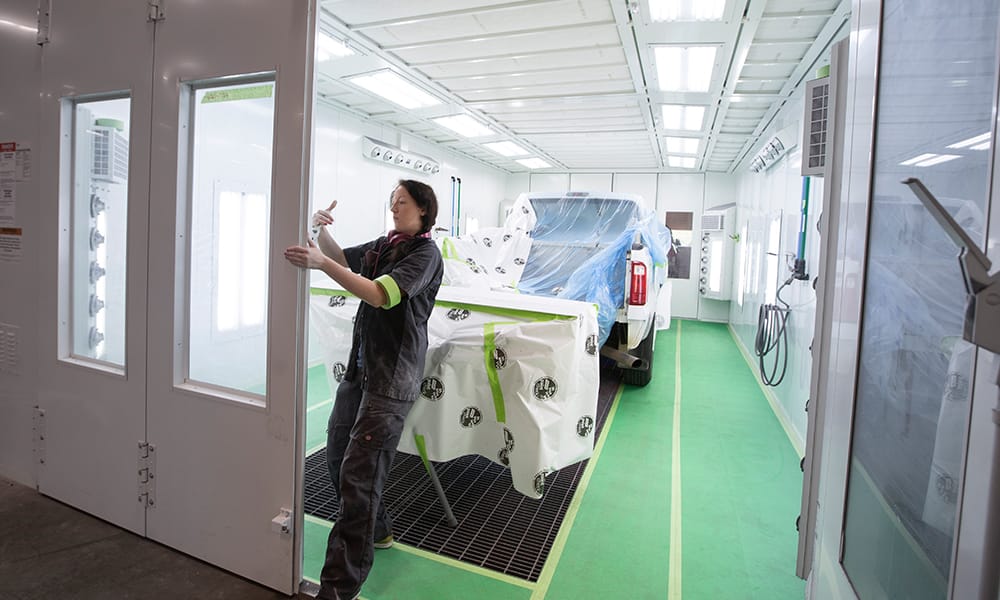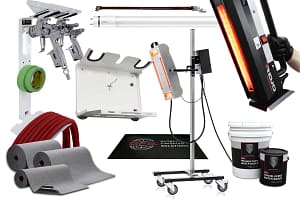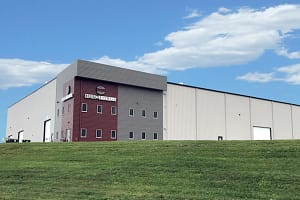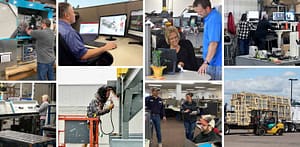
In a perfect world, achieving code compliance for your paint booth would be a one-size-fits-all process. In reality, different cities have different ordinances and permit requirements, resulting in a lot of variation in the process.
Our goal at Global Finishing Solutions (GFS) is to help customers every step of the way.
Before the first vehicle, part or piece of equipment can be moved into a paint booth, code compliance must be achieved. The booth must be built and assembled in accordance with multiple national and international standards for the safety of workers and protection of equipment.
To maximize functionality, ensure proper airflow and create a safe finishing environment, GFS paint booths comply with the International Fire Code (IFC) and National Fire Protection Association (NFPA) codes. Many standard GFS paint booth models have also attained ETL and/or ETL-C (Canada) listing — proof of compliance with North American safety standards, including OSHA, NFPA and UL. A UL or CUL (Canada) listing verifies that Underwriters Laboratories has tested GFS’ products, determining they meet the UL’s stringent requirements.
The first step in the paint booth installation process is to obtain all necessary permits. It is the responsibility of the shop or business to secure applicable construction permits, while GFS or your distributor will secure electrical permits. Local contractors handle fire suppression, working with building inspectors to meet local codes and NFPA 33.
Next, installation plans are developed. For automotive refinish paint booths, this will typically be done by your GFS distributor. For industrial paint booths, GFS designers usually work directly with customers to develop installation plans. Either way, GFS and/or your distributor will develop a solution that addresses a range of questions, most notably:
Power Source: Do you have adequate power? Do you have three-phase or single-phase power?
Fuel Source: If your paint booth is heated, most burners require at least 1 million BTU. Is your gas supply adequate? How far away is the source?
Building Engineering: Will the installation of the paint booth compromise any part of your building? Are you moving walls or cutting holes in structural supports?
Roof Reinforcement: When cutting holes for roof openings, you might weaken the integrity of the roof. Is support required?
Pit Excavation: If you have a downdraft booth, do pit plans need to be included with your permit applications?
Code Compliance: Is the Authority Having Jurisdiction (AHJ) aware of your project? Do you know what codes and standards the AHJ is enforcing?
GFS paint booth components are shipped in eco-friendly cardboard boxes and meticulously assembled by GFS or distributor installers using forklifts, skyjacks and sometimes cranes.
Installation time can range from a day to weeks or even longer, depending on the complexity and size of the project. GFS or distributor field technicians handle the entire installation when the customer chooses not to do it themselves. That includes building the cabin of the paint booth, running ductwork to roof openings and installing lighting. Precision is required for the finer points of the installation, such as power and fuel hookup, and electrical and pneumatic controls.
Unlevel ground is one of the biggest obstacles when installing a paint booth, as a level floor is required for the booth to be considered code compliant. The Ultra® Paint Booth line from GFS features floor track leveling — a major benefit to speed up installation time.
“When the ground is uneven, or we have a quarter-inch intolerance, we make adjustments without structurally affecting the booth,” said Jon Sygulla, installation coordinator for GFS. “If it is anything more than that, we work with our structural engineers to verify how to sufficiently support the booth and meet design requirements.”
GFS field installers are experienced at tackling floor leveling issues. They also have a wealth of experience with regard to code compliance — for instance, knowing proper placement of control panels so they are not too close to doors; or knowing that air solenoid valves are required for booths in Canada. That is why having the expertise of GFS is a distinct advantage.
GFS will work with you to design, engineer, manufacture and install equipment for your unique needs. The objective is worry-free planning, thanks to GFS’ in-house team of project managers.
One of the best ways to highlight your business is through a story that you can share across your online platforms. It humanizes your business and shows that your business can make a meaningful impact. Your testimonial would be used as a project profile on the GFS Booth Blog and can be shared on your website and/or social media channels.
Complete this form and we’ll be in touch to showcase your company.

Shop a variety of GFS aftermarket products, including booth protection products and mobile accelerated curing units. And enjoy the convenience of fast and free ground shipping throughout the contiguous United States.

Located at GFS’ headquarters in Osseo, Wisconsin, the Center for Excellence is an innovative facility featuring an automotive refinish training center, as well as a separate space dedicated to technical product training.

GFS is continuously searching for talented, ambitious individuals to join our team. We aim to provide our employees with every opportunity to make an impact on the company and find their niche along the way — weather in a production, field services or an office position.